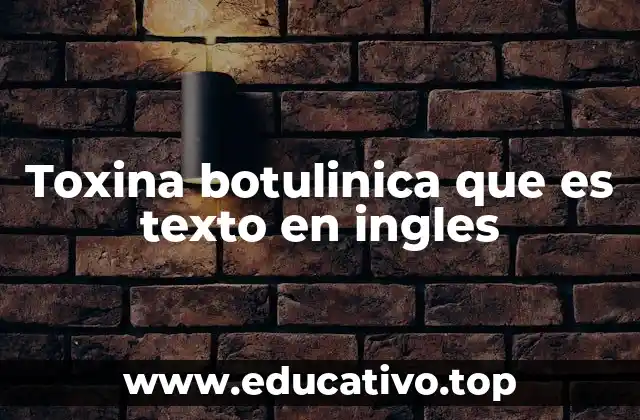La toxina botulínica es una molécula biológica de gran relevancia en diversos campos, desde la medicina hasta la estética. Este artículo se enfoca en proporcionar una descripción completa, precisa y en inglés, sobre qué es la toxina botulínica, sus usos, sus orígenes y su impacto en la sociedad moderna. A lo largo de los siguientes títulos, exploraremos los múltiples aspectos de esta sustancia, con el objetivo de ofrecer una guía informativa y útil para lectores interesados en su comprensión desde un enfoque técnico, histórico y aplicado.
What is Botox and how does it work?
Botox, or botulinum toxin, is a neurotoxic protein produced by the bacterium *Clostridium botulinum*. It is one of the most potent toxins known to science, capable of causing a severe illness called botulism. However, in controlled and diluted forms, it has become a cornerstone in both medical and cosmetic treatments.
When administered in small doses, Botox works by blocking the release of a neurotransmitter called acetylcholine, which is responsible for signaling muscle contractions. By inhibiting this process, the toxin causes temporary muscle paralysis, which is why it is so effective in reducing wrinkles and treating various medical conditions.
The medical and aesthetic applications of Botox
Beyond its use in reducing facial lines and wrinkles, Botox has a wide range of medical applications. It is FDA-approved for treating conditions such as chronic migraines, excessive sweating (hyperhidrosis), muscle spasms, and even certain bladder disorders. In the medical field, Botox is often used in neurology and urology due to its ability to relax overactive muscles and reduce pain.
In the aesthetic world, Botox has revolutionized the way people approach aging. It is commonly used to smooth out frown lines, crow’s feet, and forehead lines. Its non-invasive nature and quick recovery time have made it one of the most popular cosmetic procedures worldwide. According to the American Society of Plastic Surgeons, Botox injections are the most frequently performed minimally invasive cosmetic treatment in the United States.
Botox in pop culture and celebrity trends
In recent years, Botox has become a symbol of beauty and anti-aging in pop culture. Many celebrities have openly discussed their use of Botox, contributing to its normalization and widespread acceptance. However, this has also led to the rise of Botox face, a term used to describe overly frozen or unnatural expressions caused by overuse of the treatment. Social media influencers and beauty gurus often debate the ethical implications of Botox in the context of body image and self-perception.
Despite these debates, the popularity of Botox continues to grow, with new advancements in the field offering more natural-looking results and longer-lasting effects.
Examples of Botox treatments and their benefits
- Cosmetic Uses:
- Wrinkle Reduction: Targets dynamic wrinkles caused by facial expressions.
- Smile Lines and Crow’s Feet: Smooths out fine lines around the eyes.
- Lip Lines: Reduces vertical lines on the upper lip.
- Medical Uses:
- Chronic Migraines: Reduces the frequency and intensity of migraines.
- Hyperhidrosis: Treats excessive sweating under the arms, hands, and feet.
- Spasticity: Helps relax overactive muscles in patients with cerebral palsy or stroke.
- Other Applications:
- Blepharospasm: Treats involuntary eyelid twitching.
- Strabismus: Corrects misaligned eyes.
- Urinary Incontinence: Manages overactive bladder.
The science behind Botox: How it affects the nervous system
At a molecular level, Botox works by binding to nerve terminals and preventing the release of acetylcholine, a chemical messenger that facilitates muscle contractions. This mechanism is what leads to the temporary paralysis of the targeted muscles. The effects of Botox injections typically last between three to six months, after which the body naturally breaks down the toxin and muscle function is gradually restored.
Researchers continue to explore the full potential of botulinum toxin, including its use in treating psychiatric conditions and neurological disorders. Recent studies have suggested that Botox may also have applications in the treatment of depression and anxiety, although more research is needed to confirm these findings.
Top 10 uses of Botox across the world
- Facial Wrinkles
- Migraine Treatment
- Excessive Sweating
- Muscle Spasms
- Blepharospasm
- Strabismus Correction
- Urinary Incontinence
- Hyperhidrosis in Hands and Feet
- Gummy Smile Correction
- Treatment of Chronic Cervical Dystonia
Each of these uses is supported by clinical studies and FDA approvals, making Botox a versatile tool in modern medicine and aesthetics.
Understanding the role of Botox in modern medicine
Botox has transformed the way doctors approach certain medical conditions. For example, in neurology, it is used to treat movement disorders and chronic pain. In urology, it helps manage overactive bladder symptoms. In dermatology, it treats hyperhidrosis. Its ability to block nerve signals makes it a powerful tool in targeted therapy.
The development of Botox as a medical treatment is a prime example of how a naturally occurring toxin can be repurposed for human benefit. This transformation is a testament to the progress of biomedical science and the importance of rigorous clinical research.
What is Botox used for?
Botox is used for a variety of both cosmetic and medical purposes. In the cosmetic realm, it is primarily used to reduce the appearance of wrinkles and fine lines. In the medical field, it is prescribed for conditions such as chronic migraines, muscle spasms, and hyperhidrosis.
For example, in the treatment of chronic migraines, Botox is injected into specific areas of the head and neck to prevent pain signals from being transmitted. In patients with spasticity due to cerebral palsy, Botox injections help relax overactive muscles, improving mobility and quality of life.
Botulinum toxin: An overview of its properties and classification
Botulinum toxin is classified as a neurotoxin, a type of poison that affects the nervous system. It is one of the seven known types of botulinum toxin (A through G), with type A being the most commonly used in medical and cosmetic applications. Each type has slightly different properties and is suited for specific uses.
The toxin is produced in anaerobic conditions by the bacterium *Clostridium botulinum*. In its natural form, it is extremely dangerous and can cause botulism, a rare but serious illness. However, when purified and diluted, it becomes a powerful therapeutic agent.
The role of Botox in the beauty industry
The beauty industry has embraced Botox as a non-surgical alternative to facelifts and other invasive procedures. Its popularity is driven by its minimal downtime and quick results. Unlike surgical interventions, Botox injections require no anesthesia and can be completed in under 30 minutes.
Celebrities and influencers have played a significant role in popularizing Botox. However, the treatment is not without controversy. Concerns about overuse, unnatural results, and the potential for dependency have sparked debates about the ethics of cosmetic enhancements.
The meaning and definition of Botox
Botox is a brand name for a purified form of botulinum toxin type A. It is one of several brands available on the market, including Dysport, Xeomin, and Jeuveau. While these products are similar in function, they differ slightly in formulation and duration of effect.
In medical terms, botulinum toxin is defined as a protein toxin that acts as a blocker of neurotransmitters. It is used in both therapeutic and cosmetic contexts to achieve specific physiological effects. Its mechanism of action is based on its ability to inhibit nerve-muscle communication.
What is the origin of the term Botox?
The term Botox is derived from the name of the bacterium *Clostridium botulinum*, which produces the toxin. The Bo in Botox stands for *botulinum*, and the tox is short for *toxin*. The name was coined by the pharmaceutical company Allergan, which developed the product for commercial use in the 1980s.
Initially, Botox was used to treat eye muscle disorders. It wasn’t until the 1990s that its cosmetic potential was discovered, when patients noticed a reduction in wrinkles after receiving treatments for other conditions.
Alternative names and synonyms for Botox
Botox is also known by several other names depending on the brand and region. Common synonyms include:
- Dysport (AbobotulinumtoxinA)
- Xeomin (IncobotulinumtoxinA)
- Jeuveau (PrabotulinumtoxinA)
- Myobloc (Botulinum Toxin Type B)
These products are all forms of botulinum toxin, but they differ slightly in terms of potency, onset time, and duration. Understanding these differences can help patients and practitioners choose the most appropriate treatment for their needs.
Why is Botox so popular in cosmetic treatments?
Botox’s popularity in cosmetic treatments stems from several factors:
- Non-Invasive: No surgery or anesthesia is required.
- Quick Results: Effects are visible within a few days.
- Minimal Downtime: Patients can resume normal activities immediately.
- Customizable: Treatments can be tailored to individual needs.
- Proven Safety: When administered by a qualified professional, Botox is considered very safe.
These advantages have made Botox a go-to solution for people looking to maintain a youthful appearance without undergoing more invasive procedures.
How to use Botox: A complete guide
Using Botox requires the expertise of a licensed medical professional. Here’s a step-by-step overview of how it is typically administered:
- Consultation: The patient meets with a doctor to discuss goals and medical history.
- Preparation: The treatment area is cleaned and numbed if necessary.
- Injections: Small amounts of Botox are injected into targeted muscles.
- Post-Treatment: Patients are advised to avoid lying down or massaging the injection site for 4 hours.
It is important to follow the doctor’s post-treatment instructions to ensure optimal results and minimize side effects.
The future of Botox and emerging trends in botulinum toxin research
Research into botulinum toxin is ongoing, with scientists exploring new applications and formulations. Some of the emerging trends include:
- Longer-Lasting Formulations: Researchers are developing versions of Botox that last longer than the current 3-6 months.
- Non-Facial Applications: Botox is being tested for use in treating chronic pain, obesity, and even certain psychiatric conditions.
- At-Home Kits: While still controversial, some companies are developing at-home Botox alternatives, though they are not yet approved for widespread use.
These developments could further expand the role of botulinum toxin in medicine and aesthetics.
The importance of choosing a qualified provider for Botox treatments
One of the most critical factors in receiving safe and effective Botox treatments is choosing a qualified provider. Botox should only be administered by a licensed medical professional with experience in cosmetic or medical injections. Unqualified providers can lead to complications such as asymmetry, drooping eyelids, or overcorrection.
Patients should also be aware of the risks associated with Botox, including bruising, swelling, and temporary muscle weakness. A thorough consultation with a doctor is essential to determine if Botox is the right choice for an individual.
Fernanda es una diseñadora de interiores y experta en organización del hogar. Ofrece consejos prácticos sobre cómo maximizar el espacio, organizar y crear ambientes hogareños que sean funcionales y estéticamente agradables.
INDICE









